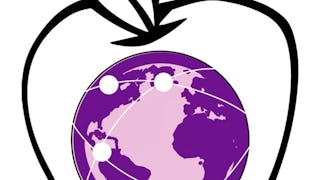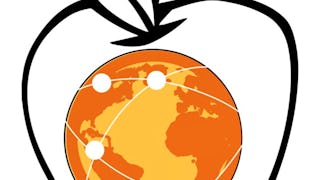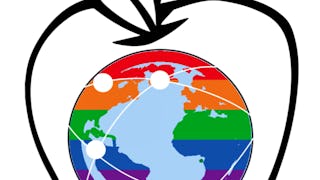In diesem Kurs werden Sie sich darauf konzentrieren, wie "intelligente" Geräte die Art und Weise verändert haben, wie wir mit anderen auf persönliche Weise interagieren und wie wir in unserer zunehmend mobilen Gesellschaft in Verbindung bleiben. Dies geschieht durch eine Reihe von gepaarten Unterrichtsabschnitten, in denen eine bestimmte "Auswirkung des Computers" in Ihrem typischen Alltag und die "Technologien und Computerkonzepte", die diese Auswirkung ermöglichen, erforscht werden, alles auf einem K12-gerechten Niveau.

Genießen Sie unbegrenztes Wachstum mit einem Jahr Coursera Plus für 199 $ (regulär 399 $). Jetzt sparen.

Auswirkungen der Technologie auf den Unterricht: Beziehungen
Dieser Kurs ist Teil von Spezialisierung für Auswirkungen der Technologie auf den Unterricht in der K-12 Bildung

Dozent: Beth Simon
2.141 bereits angemeldet
Bei enthalten
Kompetenzen, die Sie erwerben
- Kategorie: Theoretische Informatik
- Kategorie: K-12-Pädagogik
- Kategorie: Didaktische Strategien
- Kategorie: Lektionsplanung
- Kategorie: Facebook
- Kategorie: Datenspeicherung
- Kategorie: Bewusstsein für Vielfalt
- Kategorie: Geografische Informationssysteme
- Kategorie: Bildanalyse
- Kategorie: Grundsätze der Programmierung
- Kategorie: Software-Ingenieur
- Kategorie: Soziale Auswirkungen
- Kategorie: Informatik
- Kategorie: Studentisches Engagement
- Kategorie: Algorithmen
Wichtige Details

Zu Ihrem LinkedIn-Profil hinzufügen
7 Aufgaben
Erfahren Sie, wie Mitarbeiter führender Unternehmen gefragte Kompetenzen erwerben.

Erweitern Sie Ihre Fachkenntnisse
- Lernen Sie neue Konzepte von Branchenexperten
- Gewinnen Sie ein Grundverständnis bestimmter Themen oder Tools
- Erwerben Sie berufsrelevante Kompetenzen durch praktische Projekte
- Erwerben Sie ein Berufszertifikat zur Vorlage

In diesem Kurs gibt es 5 Module
Herzlich willkommen! Sind Sie daran interessiert, über die Auswirkungen der Technologie auf unsere Beziehungen zu unterrichten? Möchten Sie mehr über die Berechnungen und Konzepte erfahren, die diesen Technologien zugrunde liegen? Wir werden einen problemorientierten Ansatz verwenden, um interessante Wege zu finden, Konzepte von Netzwerken und dem Internet, Daten und Analysen und sogar Algorithmen und Datendarstellung zu vermitteln. Schließlich werden wir zwei Unterrichtspläne bewerten, kritisieren und verbessern/personalisieren - einen Ihrer Wahl und einen über Pixel. Insbesondere werden wir versuchen, diese Unterrichtspläne zu verbessern, indem wir die interaktive Lernzeit für die Schüler erhöhen.
Das ist alles enthalten
2 Videos3 Lektüren1 Aufgabe1 Diskussionsthema
Wie hat sich Ihre Fähigkeit, mit Freunden und Familie in Kontakt zu treten, verändert, seit die sozialen Medien so allgegenwärtig sind? Mit welchen verschiedenen Gruppen von Menschen sind Sie verbunden? Wir werden uns nicht nur mit den Auswirkungen der sozialen Medien auf unser Leben und die Gesellschaft befassen, sondern auch einen detaillierten Blick auf die Geschichte und die Entwicklung des Facebook-Newsfeed-Algorithmus werfen und etwas über Softwaretechnik, Benutzererfahrung und Heuristiken lernen. Durch die Interaktion mit einem Facebook-Visualisierungstool werden wir neugierig darauf sein, zu untersuchen, was dazu führt, dass Programme so lange brauchen, um zu laufen, und wie Informatiker kategorisieren, wie lange es dauert, bis Programme laufen.
Das ist alles enthalten
11 Videos9 Lektüren3 Aufgaben6 App-Elemente3 Diskussionsthemen
Da immer mehr Informationen über unseren Aufenthaltsort gesammelt werden, haben wir neue Möglichkeiten, Freunde zu finden und Beziehungen zu den Menschen in unserer Nähe zu pflegen. Wir sehen uns verschiedene Apps an, die dies nutzen, und beschäftigen uns mit digitalen Bilddarstellungen, die zur Unterstützung von Filtern wie bei Snapchat benötigt werden.
Das ist alles enthalten
4 Videos7 Lektüren2 Aufgaben4 App-Elemente1 Diskussionsthema
In dieser Woche stellen wir Ihnen das Computer Science K-12 Framework und die Computer Science Teachers Association K-12 Computer Science Standards vor, die die staatlichen K-12 Computer Science Standards in den USA zu gestalten beginnen. Wir werden Sie dabei unterstützen, einen Unterrichtsplan für eine bestimmte Klassenstufe zu finden und zu entwickeln, der sich mit den Auswirkungen der Technologie auf die Kultur befasst. Als Nächstes werden wir etwas über die weitere Differenzierung und Definition von "aktivem Lernen" anhand des ICAP-Lernrahmens (interaktiv, konstruktiv, aktiv, passiv) erfahren und sehen, wie Peer Instruction zur Förderung interaktiver Lernerfahrungen eingesetzt werden kann.
Das ist alles enthalten
9 Videos2 Lektüren1 Aufgabe
In dieser Woche geht es darum, Ihnen die Zeit und den Anlass zu geben, Unterrichtspläne zu entwickeln, die Sie verwenden (und/oder mit Kollegen teilen) können. Wir werden die Unterrichtspläne (einschließlich desjenigen, den Sie letzte Woche erstellt haben) verbessern, um den Anteil des "interaktiven" Lernens darin zu erhöhen. Außerdem werden wir versuchen, diese Lektionen an den CSTA-Standards auszurichten - wobei wir uns darüber im Klaren sind, dass diese Lektionen vielleicht schon erstellt wurden, bevor es die CSTA-Standards gab. Wenn wir jedoch sehen, wie sie mit den Standards übereinstimmen (oder auch nicht), können wir uns Anregungen holen, wie diese Lektionen verändert werden können.
Das ist alles enthalten
1 Video1 Lektüre1 App-Element2 Diskussionsthemen
Erwerben Sie ein Karrierezertifikat.
Fügen Sie dieses Zeugnis Ihrem LinkedIn-Profil, Lebenslauf oder CV hinzu. Teilen Sie sie in Social Media und in Ihrer Leistungsbeurteilung.
Dozent

Mehr von Bildung entdecken

University of California San Diego

University of California San Diego

University of California San Diego

University of California San Diego
Warum entscheiden sich Menschen für Coursera für ihre Karriere?





Neue Karrieremöglichkeiten mit Coursera Plus
Unbegrenzter Zugang zu 10,000+ Weltklasse-Kursen, praktischen Projekten und berufsqualifizierenden Zertifikatsprogrammen - alles in Ihrem Abonnement enthalten
Bringen Sie Ihre Karriere mit einem Online-Abschluss voran.
Erwerben Sie einen Abschluss von erstklassigen Universitäten – 100 % online
Schließen Sie sich mehr als 3.400 Unternehmen in aller Welt an, die sich für Coursera for Business entschieden haben.
Schulen Sie Ihre Mitarbeiter*innen, um sich in der digitalen Wirtschaft zu behaupten.
Häufig gestellte Fragen
Wie haben sich Ihre Fähigkeiten, mit anderen in Kontakt zu treten, durch Facebook, Instagram oder FaceTime verändert? In diesem Kurs werden Sie untersuchen, wie unsere Fähigkeit, in einer mobilen Gesellschaft in Verbindung zu bleiben und Verbindungen zu knüpfen, durch die Technologie ermöglicht oder gehemmt wurde. Sie werden sich mit technischen Konzepten wie Software-Engineering-Prozessen, Heuristiken, der Laufzeit von Algorithmen und der Kodierung und Verarbeitung digitaler Bilder beschäftigen. Nach erfolgreicher Absolvierung dieses Kurses werden Sie in der Lage sein:
[1] verschiedene Möglichkeiten zu erörtern, wie allgegenwärtige und vernetzte Technologien unsere Fähigkeit, Beziehungen zu pflegen und neue zu schaffen, begünstigt oder behindert haben.
[2] Erläutern Sie, wie Designentscheidungen den Facebook-Newsfeed-Algorithmus beeinflusst haben, den Wert von Heuristiken, wie die Laufzeit von Algorithmen analysiert wird, und können Sie die Bildkodierung modellieren, Farben auf verschiedene Arten darstellen und Bildmodifikationen wie Filter und Unschärfen erklären.
[3] Pädagogisches Wissen in computerwissenschaftlichen Kontexten anwenden, einschließlich interaktivem und aktivem Lernen. Nutzen Sie die CSTA Computer Science K-12 Standards und interaktive Lernvorschläge für CS, um einen Unterrichtsplan Ihrer Wahl zu verbessern.
Ja! Dieser Kurs ist Bestandteil einer Specialization, die zu einer Reihe von 4 Specializations gehört (alle werden auf Coursera angeboten), die die Anforderungen der California Supplementary Authorization unterstützen werden. Darüber hinaus kann die Specialization auch zur Erlangung von Berechtigungen in anderen Staaten beitragen. Die meisten Staaten verlangen jedoch ein Zeugnis von einer akkreditierten Hochschuleinrichtung. Wie Sie eine solche Bescheinigung erhalten, erfahren Sie in der FAQ-Frage "Erhalte ich eine Hochschulanrechnung".
Ja, Sie können sich diesen Kurs an der UCSD anrechnen lassen, aber nur, wenn Sie die komplette Specialization Teaching Impacts of Technology in K-12 Education absolvieren. Zusätzlich müssen Sie (1) einen weiteren UCSD Extension-Kurs belegen, bevor Sie das Capstone-Projekt abschließen ($500) und (2) einen Teil des Capstone-Projekts über einen Online-Prüfungsservice abschließen. Danach werden die Noten Ihrer Specializations-Kurse kumuliert, und Sie erhalten von der UCSD ein Zeugnis mit Ihrer Abschlussnote (sowohl mit Briefnote als auch mit "pass-only"-Unterstützung), das 4 Einheiten auf Graduiertenebene enthält. Diese können auf die California Supplementary Authorization angerechnet werden.
Weitere Fragen
Finanzielle Unterstützung verfügbar,

